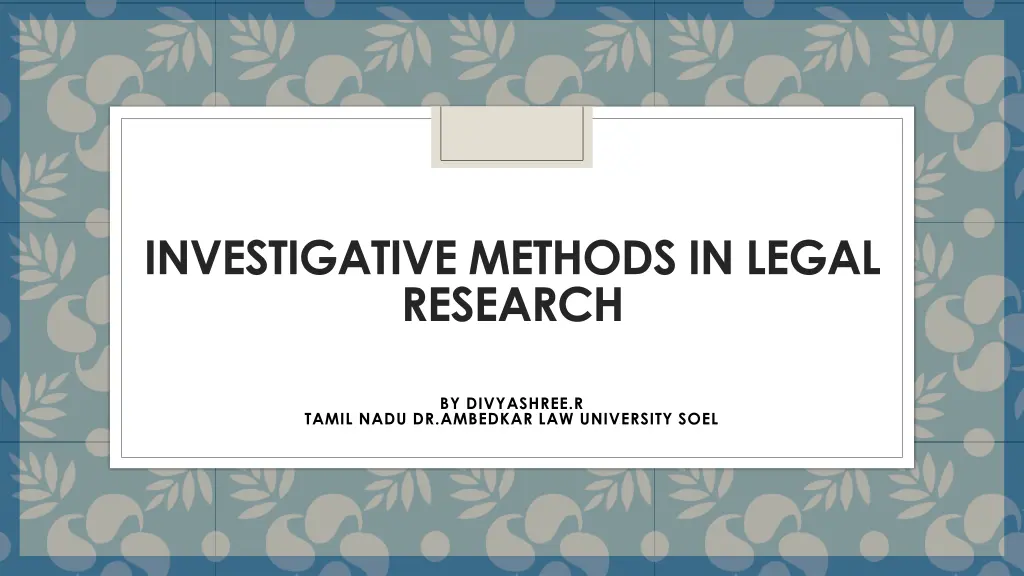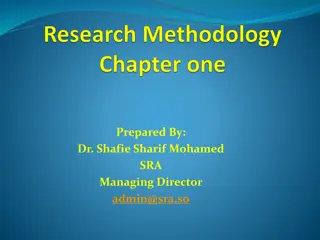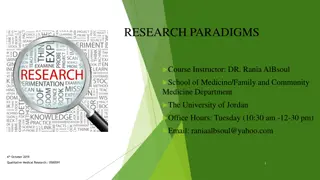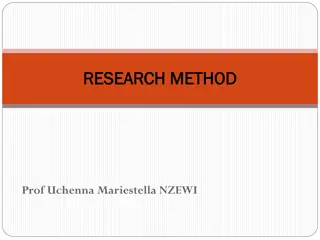
Investigative Methods in Legal Research by Divyashree R. Tamil Nadu Dr. Ambedkar Law University
Explore the investigative methods in legal research as per Divyashree R.'s study at Tamil Nadu Dr. Ambedkar Law University. Discover scientific, case study, survey, experiment, and discussion methods, along with the scientific method of investigation, steps in scientific investigation, importance, limitations, and case study method. Dive into the assumptions, sources, and significance of the case study method in legal research.
Download Presentation

Please find below an Image/Link to download the presentation.
The content on the website is provided AS IS for your information and personal use only. It may not be sold, licensed, or shared on other websites without obtaining consent from the author. If you encounter any issues during the download, it is possible that the publisher has removed the file from their server.
You are allowed to download the files provided on this website for personal or commercial use, subject to the condition that they are used lawfully. All files are the property of their respective owners.
The content on the website is provided AS IS for your information and personal use only. It may not be sold, licensed, or shared on other websites without obtaining consent from the author.
E N D
Presentation Transcript
INVESTIGATIVE METHODS IN LEGAL RESEARCH BY DIVYASHREE.R TAMIL NADU DR.AMBEDKAR LAW UNIVERSITY SOEL
METHODS IN LEGAL RESEARCH Scientific method Case study method Survey method Experiment method Discussion method
SCIENTIFIC METHOD OF INVESTIGATION Using experiments and empirical analysis to aid the legal research. Consist of two ideas: 1.Inquiry: Hypothetical or experimental approach to theory and practice. 2.Theory validation: Process of building explanatory theories about law.
STEPS IN SCIENTIFIC INVESTIGATION 1.Question :Legal problem which a person has to solve. 2. Hypothesis: assumptions to be solutions of the question. 6. Conclusion : Final result of the research. 5. Analysis: comparing results with predictions. 3.Experiment: The test 4.Observation : Results of the experiment
IMPORTANCE of scientific method LIMITATION of scientific method standardized approach to conducting field experiments Science cant prove everything science cannot answer questions about morality, as scientific results lay out of the scope of cultural, religious and social influences. Empirical research tries to gain knowledge by observing what is going on in reality.
CASE STUDY METHOD Detailed examination of a particular case intensive investigation of the particular unit under consideration. relies on multiple sources of evidence, and benefits from the prior development of theoretical propositions.
ASSUMPTIONS OF CASE STUDY METHOD assumption of uniformity in the basic human nature in spite of the fact that human behavior may vary according to situations. assumption of a detailed study of the unit . assumption of studying the natural history of the unit
SOURCES OF CASE STUDY METHOD There are many sources for a case study. Few of them are: Documentation(case laws) Interviews Physical artefact Observation : direct(observing the activities of the group) participant(the researcher involves in the activities of the group)
STEPS IN CASE STUDY METHOD Determine the research question. Choose the cases and determine how data is to be gathered and which techniques for analysis you ll be using. Multiple sources and data analysis methods are recommended. Collect the data in the field . Collect and organize the data, keep good field notes and maintain an organized database. Analyze the data. Prepare your report
ADVANTAGES of case study LIMITATIONS of case study facilitates intensive study of social units consumes more time and requires lot of expenditure as they collect even the Helps in constructing the appropriate minute details for the study. questionnaire based on several assumptions which makes possible the study of legal and may not be very realistic at times social changes by time. can be used only in a limited sphere.
SURVEY METHOD sampling of units from a population and administering data collection techniques on that sample.
TYPES OF SURVEY METHOD BASED ON MODE OF SURVEY BASED ON FREQUENCY OF SURVEY Interview Cross sectional survey: administered to a small sample from a larger Paper survey population within a small time frame. Telephonic survey Online survey Longitudinal surveys: survey for an extended period.
STAGES OF SURVEY METHOD Planning for a survey Data collection Data access Data management Data analysis Reporting Deployment
IMPORTANCE of survey method LIMITATIONS of survey method More Practical than other alternatives Sampled data not full data Easy to build and implement Biases and halo effects accurate picture of the situations Not Objective Responses
DISCUSSION METHOD Open ended exchange of ideas Aims at understanding and solving the problem Researchers discuss and debate on a topic to reach at valuable conclusions. DISADVANTAGES: Time consuming Not adaptable to all research problems If not properly guided it can lead to confusion






















